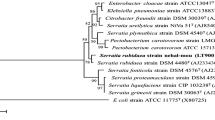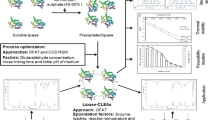Abstract
Lipase from Aspergillus niger was obtained from the solid-state fermentation of a novel agroindustrial residue, pumpkin seed flour. The partially purified enzyme was encapsulated in a sol–gel matrix, resulting in an immobilization yield of 71.4 %. The optimum pH levels of the free and encapsulated enzymes were 4.0 and 3.0, respectively. The encapsulated enzyme showed greater thermal stability at temperatures of 45 and 60 °C than the free enzyme. The positive influence of the encapsulation process was observed on the thermal stability of the enzyme, since a longer half-life t 1/2 and lower deactivation constant were obtained with the encapsulated lipase when compared with the free lipase. Kinetic parameters were found to follow the Michaelis–Menten equation. The K m values indicated that the encapsulation process reduced enzyme–substrate affinity and the V max was about 31.3 % lower than that obtained with the free lipase. The operational stability was investigated, showing 50 % relative activity up to six cycles of reuse at pH 3.0 at 37 °C. Nevertheless, the production of lipase from agroindustrial residue associated with an efficient immobilization method, which promotes good catalytic properties of the enzyme, makes the process economically viable for future industrial applications.





Similar content being viewed by others
References
Contesini FJ, Lopes DB, Macedo GA, Nascimento MG, Carvalho PO (2010) Aspergillus sp. Lipase: potential biocatalyst for industrial use. J Mol Catal B Enzym 67:163–171
Couto SR, Sanroma′n MA (2006) Application of solid-state fermentation to food industry-A review. J Food Eng 76:291–302
Edwinoliver NG, Thirunavukarasu K, Naidu RB, Gowthaman MK, Kambe TN, Kamini NR (2010) Scale-up of a novel of a tri-substrate fermentation for enhanced production of Aspergillus niger lipase for tallow hydrolysis. Bioresour Technol 101:6791–6796
Salihu A, Alam MZ, Karim IA, Salleh HM (2012) Lipase production: an insight in the utilization of renewable agricultural residues. Resour Conserv Recycl 58:36–44
Colla LM, Rizzardi J, Pinto MH, Reinehr CO, Bertolin TE, Costa JAV (2010) Simultaneous production of lipases and biosurfactants by submerged and solid substrate process. Bioresour Technol 101:8308–8314
Contesini FJ, Da Silva VCF, Maciel RF, Lima RJ, Barros FFC, Oliveira POJ (2009) Response surface analysis for the production of an enantioselective lipase from Aspergillus niger by solid-state fermentation. J Microbiol 47:563–571
Santos RCA, Araújo KB, Soares CMF, Aquino LCL (2012) Evaluation of temperature and moisture response surface on the fermentation of lipase pumpkin seeds using Aspergillus niger. Acta Sci Technol 34(3):255–260
Sharma R, Chisti Y, Banerjee UC (2001) Production, purification, characterization, and applications of lipases. Biotech Adv 19:627–662
Hasan F, Shah AA, Hameed A (2006) Industrial applications of microbial lipases. Enzym Microbial Technol 39:235–251
Chaubey A, Parshad R, Taneja SC, Qazi GN (2009) Arthrobacter sp. lipase immobilization on magnetic sol–gel composite supports for enantioselectivity improvement. Process Biochem 44:154–160
Yilmaz E, Sezgin M, Yilmaz M (2011) Immobilization of Candida rugosa lipase on magnetic sol–gel composite supports for enzymatic resolution of (R/S)-Naproxen methyl ester. J Mol Catal B Enzym 69:35–41
Yang G, Wu J, Xu G, Yang L (2009) Improvement of catalytic properties of lipase from Arthrobacter sp. by encapsulation in hydrophobic sol–gel materials. Bioresour Technol 100:4311–4316
Yang G, Wu J, Xu G, Yang L (2010) Comparative study of properties of immobilized lipase onto glutaraldehyde-activated amino-silica gel via different methods. Colloids Surf B 78:351–356
Kartal F, Akkaya A, Kilinc A (2009) Immobilization of porcine pancreatic lipase on glycidyl methacrylate grafted poly vinyl alcohol. J Mol Catal B Enzym 57:55–61
Orrego CE, Salgado N, Valencia JS, Giraldo GI, Giraldo OH, Cardona CA (2010) Novel chitosan membranes as support for lipases immobilization: characterization aspects. Carbohyd Polym 79:9–16
Rodrigues DS, Mendes AA, Adriano WS, Gonçalves LRB, Giordano RLC (2008) Multipoint covalent immobilization of microbial lipase on chitosan and agarose activated by different methods. J Mol Catal B Enzym 51:100–109
Yujun W, Jian X, Guangsheng L, Youyuan D (2008) Immobilization of lipase by ultrafiltration and cross-linking onto the polysulfone membrane surface. Bioresour Technol 99:2299–2303
Hanefeld U, Gardossi L, Magner E (2009) Understanding enzyme immobilization. Chem Soc Rev 38:46–453
Gupta R, Chaudhury NK (2007) Entrapment of biomolecules in sol–gel matrix for applications in biosensors: problems and future prospects. Biosens Bioelectron 22:2387–2399
Tomin A, Weiser D, Hellner G, Bata Z, Corici L, Peter F, Koczka B, Poppe L (2011) Fine-tuning the second generation sol–gel lipase immobilization with ternary alkoxysilane precursor systems. Process Biochem 46:52–58
Souza RL, Resende WC, Barao CE, Zanin GM, Castro HF, Santos OAA, Fricks AT, Figueiredo RT, Lima AS, Soares CMF (2012) Influence of the use of Aliquat 336 in the immobilization procedure in sol–gel of lipase from Bacillus sp. ITP-001. J Mol Catal B Enzym 84:152–159
Hara P, Hanefeld U, Kanerva LT (2008) Sol–gels and cross-linked aggregates of lipase PS from Burkholderia cepacia and their application in dry organic solvents. J Mol Catal B Enzym 50:80–86
Kharrat N, Ali YB, Marzouk S, Gargouri Y-T, Karra-Chaabouni M (2011) Immobilization of Rhizopus oryzae lipase on silica aerogels by adsorption: comparison with the free enzyme. Process Biochem 46:1083–1089
Pirozzi D, Fanelli E, Aronne A, Pernice P, Mingione A (2009) Lipase entrapment in a zirconia matrix: sol–gel synthesis and catalytic properties. J Mol Catal B Enzym 59:116–120
Reetz MT, Zonta A, Simpelkamp J (1996) Efficient immobilization of lipases by entrapment in hydrophobic sol–gel materials. Biotechnol Bioeng 49:527–534
Wolski E, Menusi E, Remonatto D, Vardanega R, Arbter F, Rigo E, Ninow J, Mazutti MA, Di Luccio M, Oliveira D, Treichel H (2009) Partial characterization of lipases produced by a newly isolated Penicillium sp. in solid state and submerged fermentation: a comparative study. Food Sci Technol 42:557–1560
INPI Patent submission No. PI0306829-3, September 11 2003
Pinheiro R, Soares C, Santos OA, Castro HF, Zanin GM (2008) Influence of gelation time on the morphological and physic-chemical properties of the sol–gel entrapped lipase. J Mol Catal B Enzym 52–53:27–33
Soares CMF, Santos OA, Moraes FF, Castro HF, Zanin GM (2006) Characterization of sol–gel encapsulated lipase using tetraethoxysilane as precursor. J Mol Catal B Enzym 39:69–79
Grobecker KH, Rückold S, Anklam E (1999) Report of the European Commission EUR 19005 EN, European Commission
Soares CMF, Castro HF, Moraes FF, Zanin GM (1999) Characterization and utilization of Candida rugosa lipase immobilized on controlled pore silica. Appl Biochem Biotechnol 77–79:745–758
Soares CMF, Santos OAA, Castro HF, Morae FF, Zanin GM (2004) Studies on lipase immobilization in hydrophobic sol–gel matrix. Appl Biochem Biotechnol 113–116:307–319
Uyanik A, Sen N, Yilmaz M (2011) Improvement of catalytic activity of lipase from Candida rugosa via sol–gel encapsulation in the presence of calix(aza)crown. Bioresour Technol 102:4313–4318
Soares CMF, Santos OAA, Olivo JE, Castro HF, Moraes FF, Zanin GM (2004) Influence of alkyl-substituted silane precursors of silica gels on the enzymatic activity of immobilized microbial lipase from Candida rugosa. J Mol Catal B Enzym 29:69–79
Mahadik ND, Puntambekar US, Bastawde KB, Khire JM, Gokhale DV (2002) Production of acidic lipase by Aspergillus niger in solid state fermentation. Process Biochem 38:715–721
Saxena RK, Davidson WS, Sheron A, Giri B (2003) Purification and characterization of an alkaline thermostable lipase from Aspergillus carneus. Process Biochem 39:239–247
Mhetras NC, Bastawde KB, Gokhale DV (2009) Purification and characterization of acidic lipase frm Aspergillus niger NCIM 1207. Bioresour Technol 100:1486–1490
Da Silva VCF, Contesini FJ, Carvalho PO (2008) Characterization and catalytic activity of free and immobilized lipase from Aspergillus niger: a comparative study. J Braz Chem Soc 19(8):1468–1474
Romero CM, Pera LM, Loto F, Vallejos C, Castro G, Baigori MD (2012) Purification of an organic solvent-tolerant lipase from Aspergillus niger MYA 135 and its application in ester synthesis. Biocatal Agr Biotechnol 1:25–31
Balcão VM, Paiva AL, Malcata FX (1996) Bioreactors with immobilized lipases: state of the art. Enzym Microb Technol 18:392–416
Mateo C, Palomo JM, Fernandez-Lorente G, Guisan JM, Fernandez-Lafuente R (2007) Improvement of enzyme activity, stability and selectivity via immobilization techniques. Enzym Microb Technol 40:1451–1463
Hiol A, Jonzo MD, Rugani N, Druet D, Sarda L, Comeau LC (2000) Purification and characterization of an extracellular lipase from a thermophilic Rhizopus oryzae strain isolated from palm fruit. Enzym Microb Technol 26:421–430
Gupta S, Yogesh Javiya S, Bhambi M, Pundir CS, Singh K, Bhattacharya A (2008) Comparative study of performances of lipase immobilized asymmetric polysulfone and polyether sulfone membranes in olive oil hydrolysis. Int J Biol Macromol 42:145–151
Acknowledgments
The authors thank the Coordination of Improvement of Personal Level Foundation (CAPES, Brazil) for the graduate scholarship granted, and the Foundation for Research and Technological Innovation of Sergipe State (FAPITEC/SE) for financial support.
Author information
Authors and Affiliations
Corresponding author
Rights and permissions
About this article
Cite this article
Zubiolo, C., Santos, R.C.A., Carvalho, N.B. et al. Encapsulation in a sol–gel matrix of lipase from Aspergillus niger obtained by bioconversion of a novel agricultural residue. Bioprocess Biosyst Eng 37, 1781–1788 (2014). https://doi.org/10.1007/s00449-014-1151-3
Received:
Accepted:
Published:
Issue Date:
DOI: https://doi.org/10.1007/s00449-014-1151-3




